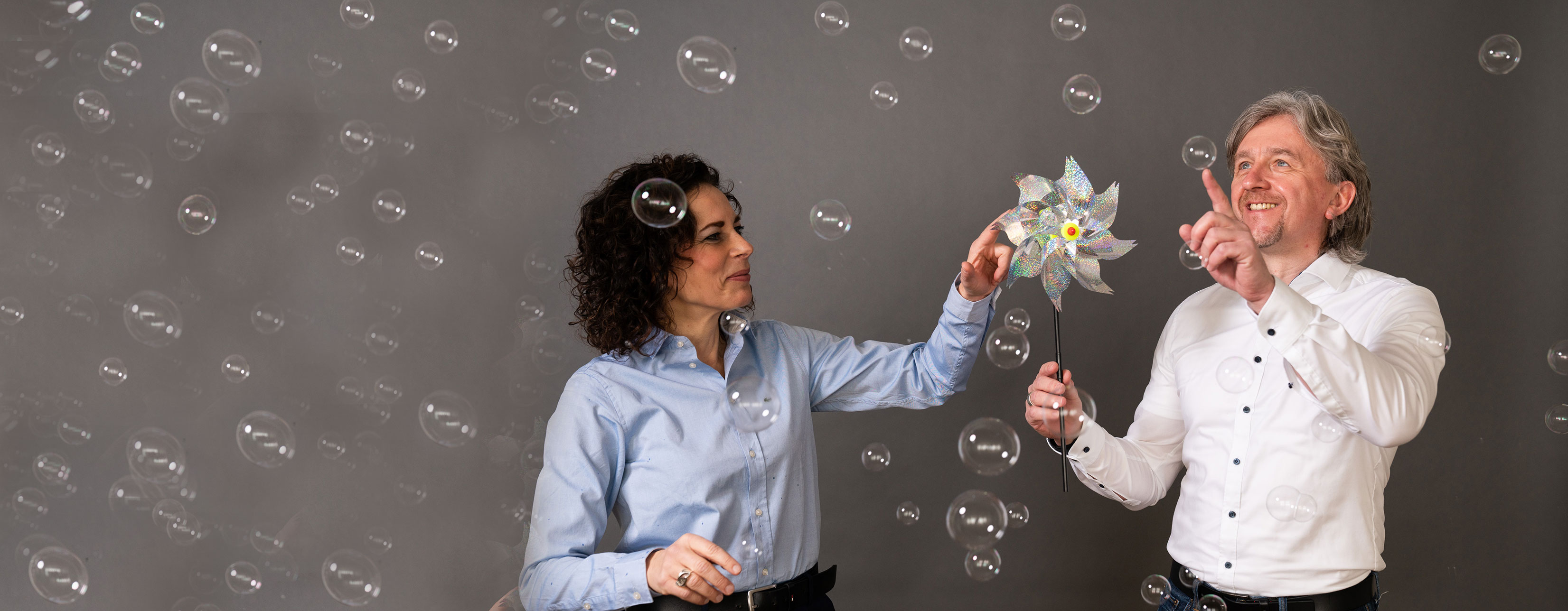Winds of Change
Web special Fraunhofer magazine 1.2022
1. The project
Harnessing offshore winds and converting their energy into electricity is a promising idea on multiple levels. Offshore winds have some advantages over winds on land − out at sea, the wind not only blows stronger, but also at a more consistent rate. That is why offshore facilities produce twice as much energy on average as their land-based counterparts, contributing significantly to the reliability of renewable energies in the process. On top of that, there are no residents at sea to complain about the noise of the rotors, and no citizens’ groups to demand that facilities are kept far away from town centers. It also means fewer legal proceedings to put the brakes on the expansion of wind energy. All this makes wind energy an attractive option − but it isn’t the full picture. There is also the technical challenge of connecting offshore wind farms to the electricity network. The long distances that electricity must travel to reach the shore are reflected in transmission losses. However, if green hydrogen (H2) will play a key role in the German energy transition, as the German federal government’s National Hydrogen Strategy asserts, why not move hydrogen production to a place where water and wind energy come together?
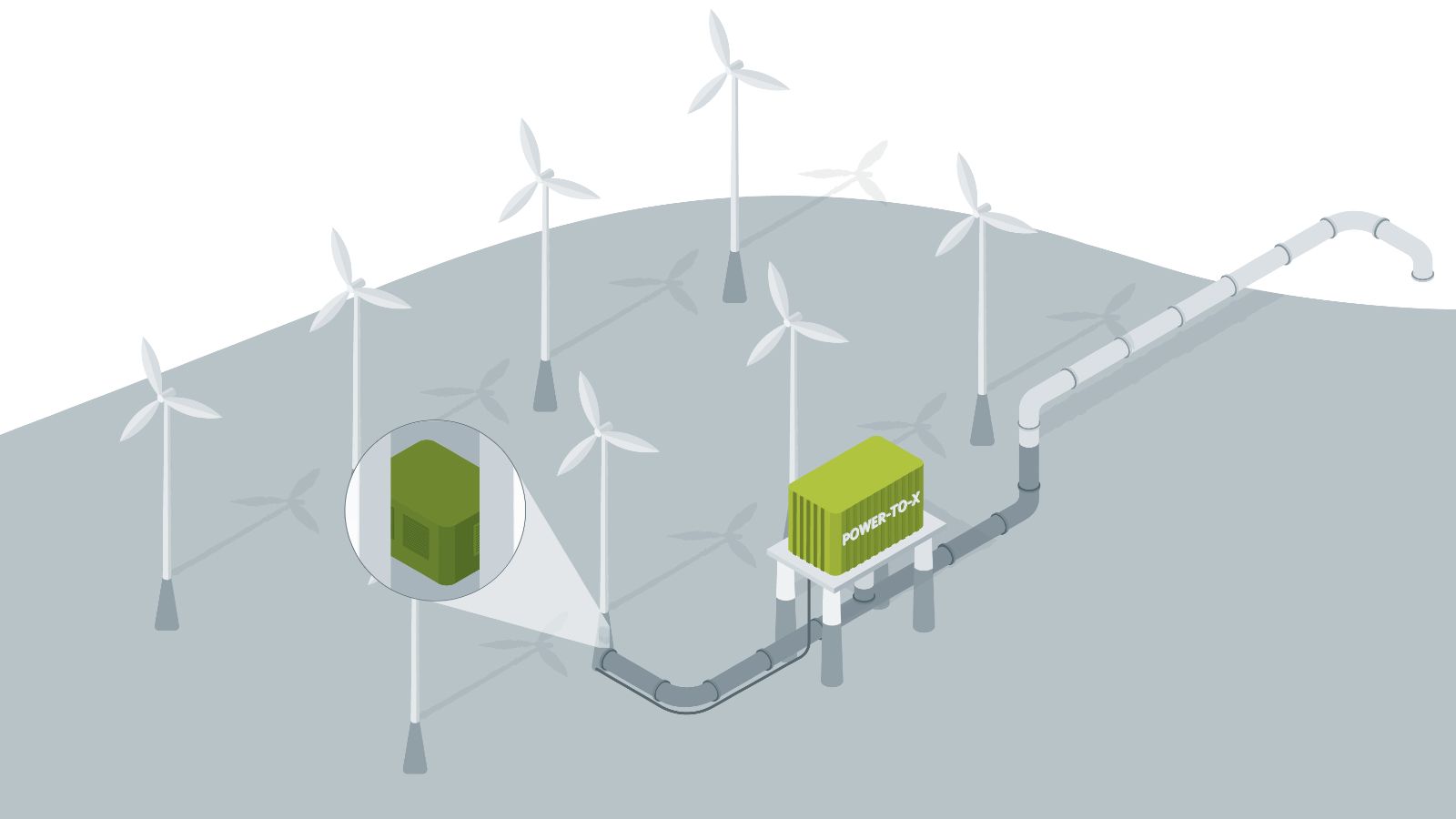
The flagship project H2Mare
The H2Mare flagship project from the German Federal Ministry of Education and Research (BMBF) is exploring just this avenue. Directly combining wind turbines and electrolyzers (the devices that break water down into its components, hydrogen and oxygen) can potentially bring about a considerable reduction in the cost of H2 production. This would make hydrogen a more appealing option for a number of possible applications from both a financial and an environmental perspective.
The Fraunhofer-Gesellschaft, alongside Siemens Energy, is a main coordinator of the large-scale H2Mare project. One of the four sub-projects is H2Wind, which is funded by the federal government to the tune of 3.5 million euros. The project focuses on a compact electrolyzer that can be directly integrated into a wind turbine. However, before this can be realized, there are still many questions to answer. How do you design an electrolyzer to withstand a harsh offshore environment? Where is the best place in the system to install it? How do you treat seawater so that it can be used as a raw material for producing hydrogen? How can the hydrogen produced offshore be stored and then transported to land later?
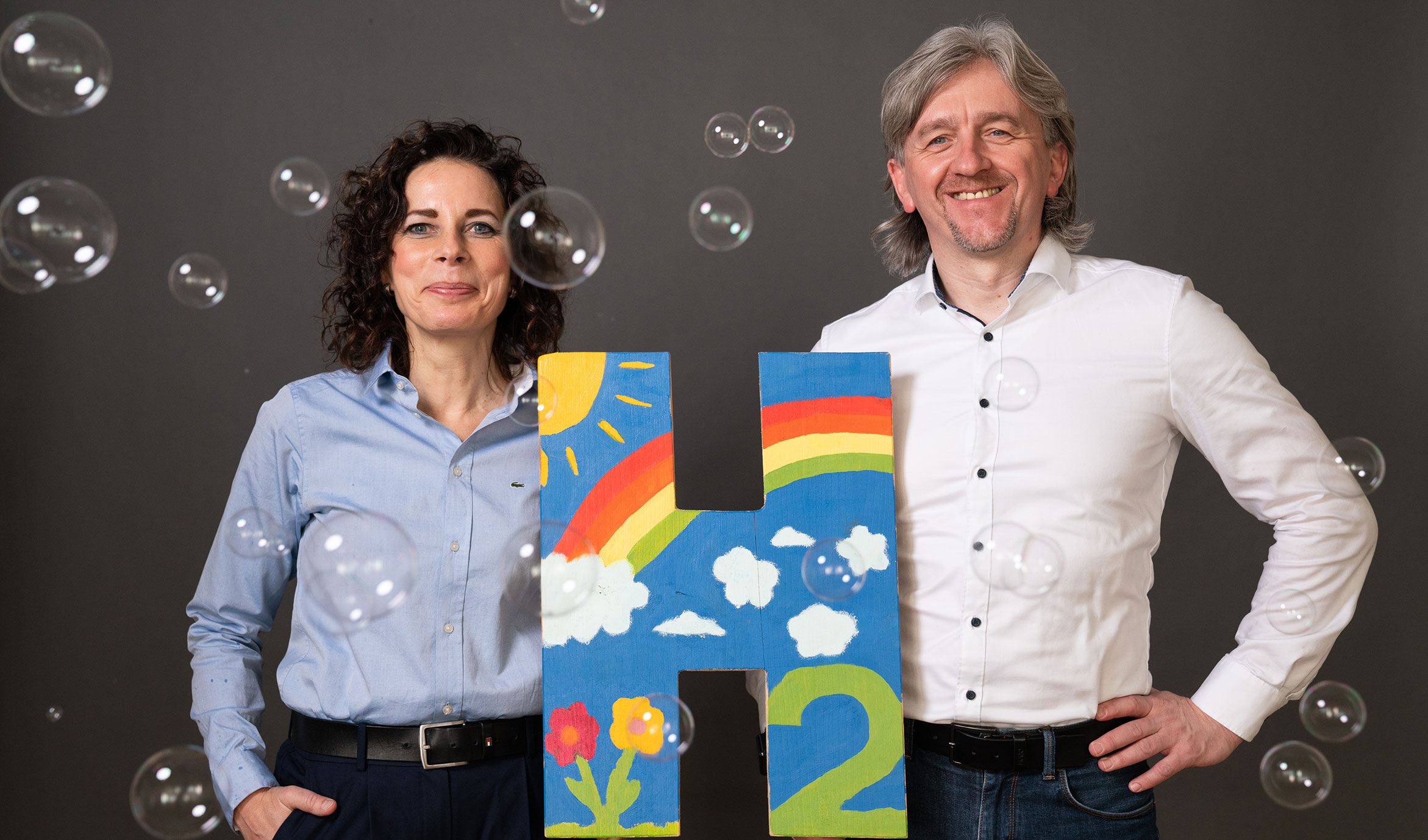
Dr. Ulrike Beyer has been heading up the Hydrogen Task Force at the Fraunhofer Institute for Machine Tools and Forming Technology IWU for two years. “Fraunhofer is positioned at the intersection between fundamental university research and industry. This means, above all, that Fraunhofer can understand the current state of research, modify it for its own goals and ensure a rapid launch to market,” says the doctor of industrial and mechanical engineering.
Time is a key factor for H2Wind. Although the project was only launched in 2021, researchers plan to present solutions for offshore electrolyzers as early as 2025. Dr. Beyer considers this deadline to be ambitious, but doable: “At Fraunhofer, the topic of hydrogen drives us both professionally and personally. Sometimes, you have to push yourself right to your limits.” However, the 51-year-old welcomes the challenge. And she sees the benefits for more than just her own institute, which has locations in Chemnitz, Dresden, Wolfsburg and Zittau. “In the Saxony region, we’re seeing many small and medium-sized companies that, until now, have been active as suppliers in the automotive sector. They’re all looking for new business areas with a view toward entering the future sector of e-mobility. The responsibility falls to us here, as we’re preparing these fields for industry.”
Hydrogen has long been considered the champagne of the energy transition. The aim now is to turn it into an energy drink for industry. “Currently, in the field of electrolyzers, almost everything is manufactured manually,” says Mark Richter, Head of Climate-Neutral Factory Operation at Fraunhofer IWU. “That’s why we must be able to produce complete systems on an industrial scale in a way that suits the mass market. Only then will we see prices drop, and from there, hydrogen will become a real option for industry.” Dr. Beyer adds that the aim is to create a “people’s electrolyzer,” namely one that is functional and inexpensive.
To Fraunhofer, H2 is far more than just a trendy topic, explains Mark Richter. “It is a strategically important and sustainable research field that not only allows us to shape the future, but also to constantly develop ourselves.” Aside from Fraunhofer IWU, the Fraunhofer Institutes for Wind Energy Systems IWES, for Microstructure of Materials and Systems IMWS, for Interfacial Engineering and Biotechnology IGB and for Chemical Technology ICT are also involved in H2Wind. “The topic of hydrogen extends across almost the entire Fraunhofer ecosystem. This means nearly everyone can make a contribution,” says Dr. Beyer. And that, adds Mark Richter, “is a cool driving force, something fun. That’s also important to recognize.”
2. The material
The principle of using electricity to split water into hydrogen and oxygen goes back more than 200 years. Today, it is usually achieved using something known as PEM (proton-exchange membrane) electrolysis. The core components of this process are electrolytic cells layered into stacks, which in turn consist of two central components: bipolar plates (BPs) and the membrane electrode assembly (MEA). BPs ensure an electrical connection and transport both between cells and to and from the MEA, where the water is split.
Bipolar plates are usually made of a special stainless steel, graphite and titanium, and are further protected against corrosion by means of a precious metal coating such as gold or platinum. The material and design of the bipolar plates are also decisive factors for the electrolyzer’s efficiency, maintenance requirements, functionality and service life. All of this, in turn, is essential for a future offshore electrolyzer to function and turn a profit while far away from land and under extreme conditions.
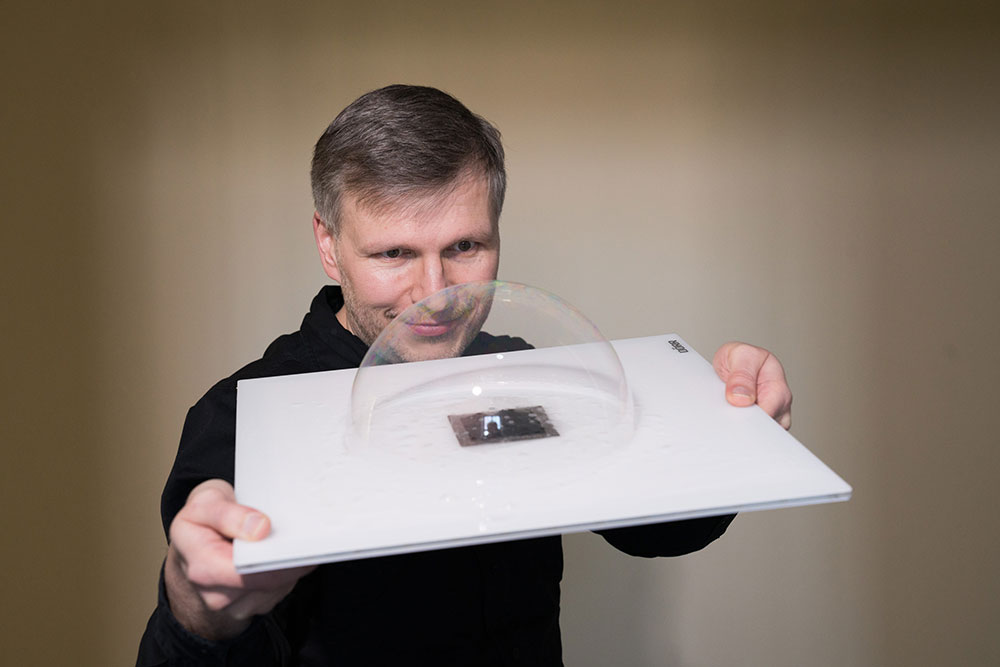
The question of materials is central to Wolfram Münchgesang’s role in H2Wind. The doctor of physics from Fraunhofer IWES acts as a go-between, coordinating the correlations between stack properties and special offshore requirements discovered at the laboratory level, the development of a research stack at the test level and, finally, the transfer of laboratory and test results to industrial application. Or, as Dr. Münchgesang puts it: “I gather information, consolidate it and try to develop an overall scientific picture on that basis.”
Although we have long been aware of the principle of electrolyzers, and their individual components, the development of an offshore electrolyzer represents a new frontier for science. If wind power is used to directly provide the energy to split water, what impact will this have? What particular stresses will the material need to withstand offshore? How will vibrations or mechanical stress, for example, affect the service life of the various components? After desalinating the seawater, will it still contain ions? Could these potentially accumulate in the stack (or elsewhere in the electrolyzer) and impair its function? There are no standardized test profiles or valid measurement scales for any of these questions. And as it’s impossible for technicians to quickly service the system on the high seas, it needs superior-quality materials to help it withstand the conditions of its offshore location.
Researchers aren’t planning to reinvent the wheel here − if only for reasons of time and money. Münchgesang sums it up pragmatically: “We design functional models for offshore operations, test them and, finally, scale them for industrial application.” By 2025 at the latest, we should be as close as possible to the ideal device for splitting water into hydrogen and oxygen. In principle, it will be the same as it was two centuries ago, only this time it’s at sea. And that’s the new frontier.
3. The storage
In Germany, offshore wind farms are located 58 kilometers from the coast on average. The electricity is usually transported to land via submarine cables that have been laid in the seabed. In the future, how can hydrogen produced offshore be taken where it is needed?
Sebastian Schmidt, project manager at the Fraunhofer Hydrogen Lab in Görlitz, and project partners Siemens, Mannesmann and other Fraunhofer institutes are developing a pipe storage system suitable for offshore use, specifically for H2Wind. They will then test various usage scenarios on the system. “During the tests, the primary aim will be to simulate aging behavior by charging and discharging the storage device in quick succession,” explains the qualified mechatronics engineer. In other words: “Filling the device with compressed hydrogen, compressing it further and draining the device again.” And again and again − this is an endurance test for the future.
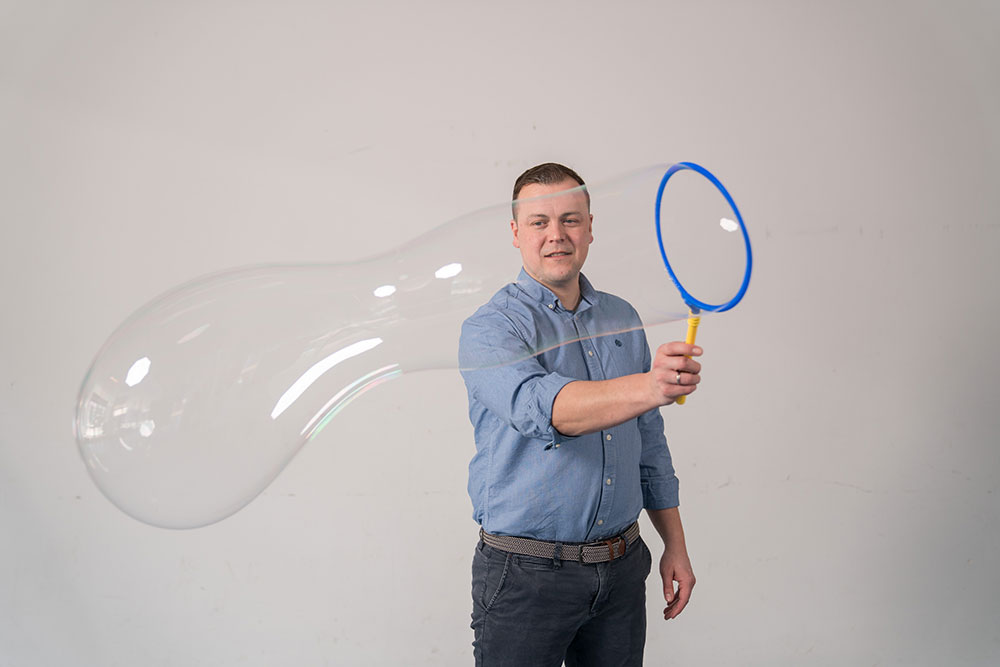
A pipe storage system is actually little more than a special variety of pipeline, says Sebastian Schmidt: “You take a pipe from a pipeline that’s already proven its ability to transport H2, increase the diameter and weld a cover on the left and right sides.” It may sound simple, but it’s not − to ensure the longest functionality possible and store the gas safely, the individual parts of this storage system will likely need to be welded together offshore and underwater, with maximum precision. As a qualified welder, Schmidt knows that this will be no easy task.
In addition, the environmental conditions at sea are different from those on land. The material that makes up the pipe storage system and the way the system is manufactured must also be designed for this environment. A particular concern is corrosion from salt water. Of course, quality and safety are not the only considerations when storing hydrogen and transporting it to land, be it by ship or pipeline − there is also the matter of cost. Every consumer is currently seeing how important this factor is as they heat their homes or refuel their cars. The energy of the future must be affordable. “Any new technology being developed for offshore use should not only be as highly automated as possible, but should also be robust, straightforward and inexpensive,” says Schmidt in summary. If the cost associated with hydrogen production cannot be reduced soon, “the German government’s greater plans for hydrogen are in danger, since the industry would not be able to finance a large-scale transition.”
Even if there are still many uncertainties when it comes to hydrogen, Schmidt believes that for a scientist, it is a “real stroke of luck” to be involved at this stage. “We are setting standards and shaping the future.” What more could a researcher ask for?
4. The water
To produce green hydrogen, you need water and green energy. This is yet another thing that makes offshore electrolysis so appealing − after all, there is no shortage of these resources at sea. This means we wouldn’t have to use precious freshwater reserves to produce hydrogen at the scale required by industry. However, the devil is in the details: Salty seawater could permanently damage the stack, which is essentially the heart of the electrolyzer. This would not only noticeably reduce the quality of the hydrogen produced, but could also exacerbate the problems associated with maintaining offshore systems, significantly shortening the lifespan of the electrolyzer. In an ideal scenario, the abundant seawater would therefore need to be treated before use. However, this would consume a lot of energy, reducing the sustainability and efficiency of hydrogen production. What can be done?
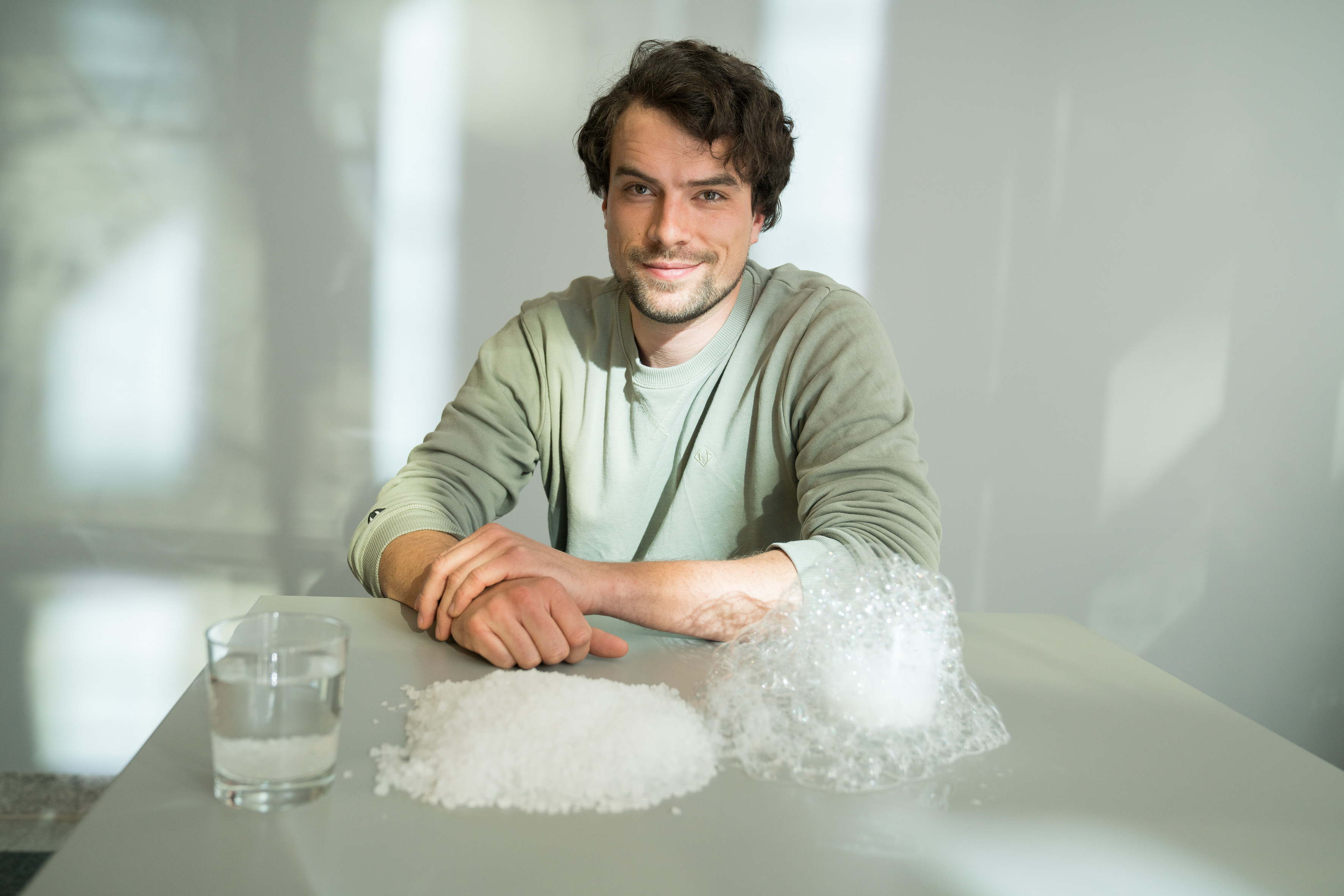
Questions like these brought chemical engineer Henner Heyen to the Fraunhofer Institute for Wind Energy Systems IWES right after he completed his studies at TU Berlin. The prospect of using wind energy to produce green hydrogen attracted him to work at the Hydrogen Lab Bremerhaven. Two locations have now been added to Fraunhofer IWES in Leuna and Görlitz, both of which conduct research along the hydrogen value chain. This opens new exciting opportunities to collaborate on future research questions.
As a project manager, Heyen is now responsible for a work package within the H2Wind project that focuses on extracting heat from the electrolyzers. This could solve the problem of energy in seawater treatment. “Until now, the waste heat generated when water is split has reduced the efficiency of electrolyzers,” explains Heyen. “But if we could at least partially intercept this energy and use it to treat seawater, things would look very different.” The scientist is already thinking beyond H2Wind: “The solutions that we are developing here for offshore plants could also one day be used for water treatment in regions where there is a shortage of drinking water.”
Heyen has already set his sights on another “waste product” of electrolysis: the oxygen that results from hydrogen production. “There are already people interested in this on land, for example in hospitals or sewage treatment plants. We are still looking for viable applications offshore.”
5. The simulation
At 28, Tom Schwarting is probably the greenest Fraunhofer employee on the H2Wind project. Until mid-2021, the information and communications engineer still thought his professional future would be in aerospace technology, and even completed his master’s degree at TU Braunschweig in this research field. As a research assistant at the Institute of Flight Guidance, he was involved in the MOSAiC polar expedition, a research expedition that saw the Polarstern icebreaker and its crew drift across the Arctic Ocean for a year, documenting the dramatic melting rate of the sea ice. It became clear to Schwarting that in the future, he would rather work for people that prevent CO2 emissions rather than those that cause them.
Since April 2021, Tom Schwarting has been part of the Factory of the Future team at Fraunhofer IWU. Within the H2Wind project, he is one of the researchers focusing on the question of what changes must be made in order to advance the production and use of green offshore hydrogen, in both environmental and economic terms. Using simulation models, he is trying to map the entire value chain for offshore hydrogen electrolysis as realistically as possible. He uses digital twins to develop, compare and finally evaluate different scenarios. “It’s a bit like a kid’s game where you have to move marbles back and forth as efficiently as possible,” says Schwarting.
But of course, it’s anything but a kid’s game. There are a huge number of potential influencing factors, not to mention the enormous challenge of properly considering the major developments in the field: How are different forms of renewable energy developing? How much will energy cost in 2025? And in the world of tomorrow, what role will hydrogen play as an industrial raw material? As energy storage? Or even as a heat source? “Our simulations are based on reliable studies, so the numbers are thoroughly substantiated,” explains Schwarting. Nevertheless, the fact remains: “It’s better to work with estimates than to start with digital simulations too late.” Otherwise, you run the risk of a chicken and egg problem: No company will opt to produce hydrogen as long as the cost and benefits are unclear. But if no one produces hydrogen, the financial aspect remains fuzzy. A simulation can help break this vicious cycle. “Right now, many people consider hydrogen to be a savior, so to speak. But it can only save us if we first generate enough green electricity for hydrogen production,” warns Schwarting. “But with every wind turbine we set up, we move a little closer to our goal.”
Further information
- How partners in the H2Mare flagship project intend to produce hydrogen on the high seas
- Hydrogen Flagship Projects of the Federal Ministry of Education and Research (BMBF)
- H2Mare flagship project (Press release August 19, 2021 Fraunhofer IWES) (iwes.fraunhofer.de)
- Fraunhofer lead market Energy Sector
- Fraunhofer Strategic Research Field Hydrogen Technologies
- High-Performance Center GreenMat4H2 – Sustainable Materials for the Hydrogen Economy
